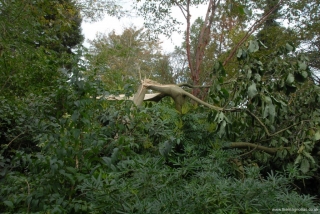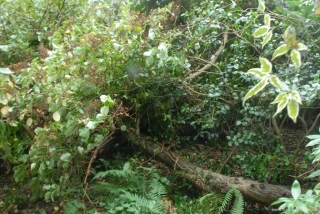We are sorry we had problems with the web site over three days, Tuesday to Thursday of this week. We have put it down to glitches in an updated piece of software.
Anyway, we did not escape unscathed from last Monday morning’s storm. One of our largest hybrid Magnolias, ‘Royal Crown’ broke off at about 10 feet up the trunk.
It was quite ironic as we had been saying there were going to be terrific new views of it from the ‘New Summer Garden’ next spring, following the removal of the old climber covered pear trees. The old trees would probably have blown over had they been there, but the Magnolia might have been protected, but we will never know!
It had many hundreds of flower buds and it has been quite sad shredding all the brushwood and cutting up the trunk and branches. However, in our experience with Magnolias, the remaining four foot of undamaged trunk will sprout vigorously next spring, and before too many years have passed we will get flowers again. It may take a while to get back to its previous dimensions of perhaps 30ft high by as much through, which is perhaps not a bad thing! There was some good news about the tree falling, in that not a single shrub underneath it was damaged significantly by its falling. In fact the very minor damage occurred mostly in the clear up, while cutting and dragging off the tree branches from out of a large Mahonia ‘Winter Sun’ and various Camellias and other shrubs.
The other tree blown completely out of the ground was a venerable cooking apple ‘Monarch’, planted by my father in the 1930s.
Apparently Monarch was preferred during the Second World War and after while sugar was rationed as less sugar is needed than with the Nation’s favourite cooking apple, ‘Bramley Seedling’. I know we prefer it of the two for flavour. Fortunately a couple of years ago I grafted a scion from it, onto a dwarfing root stock, just in case it were to succumb to disease etc.
The old tree had been covered with a substantial Climbing Hydrangea (H. petiolaris), and no doubt this was a major contributory factor to it being blown down. The hydrangea has come right out of the ground as well. We haven’t finished the clearing up of this one so don’t know the full extent of collateral damage of under planted shrubs but we think it may be worse than the insignificant damage of the bigger tree.
This is not the first tree to have been blown over because of the extra wind resistance of climbing plants supported by them. . A few years ago, we lost a completely healthy Prunus serrula in winter time when it had no leaves because of a large evergreen climber, Stauntonia hexandra which it hosted. The tree had been a fair size with a trunk close to a foot through.


